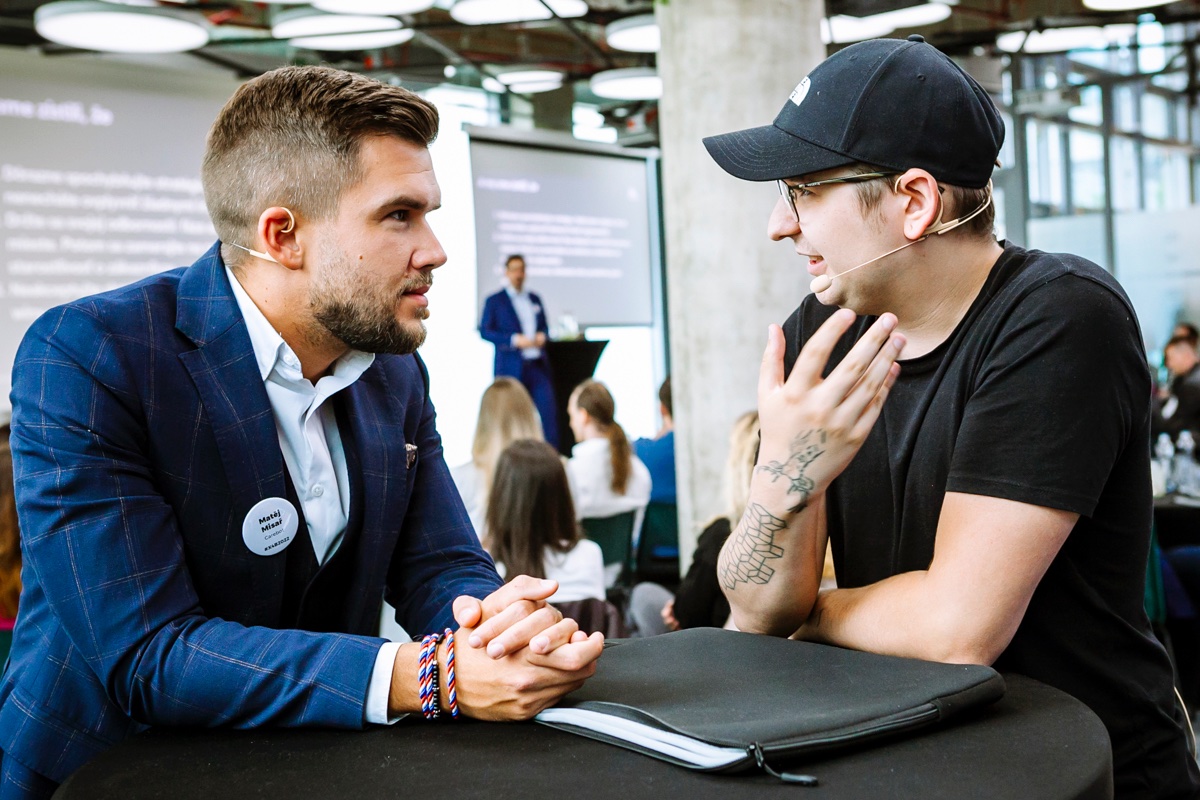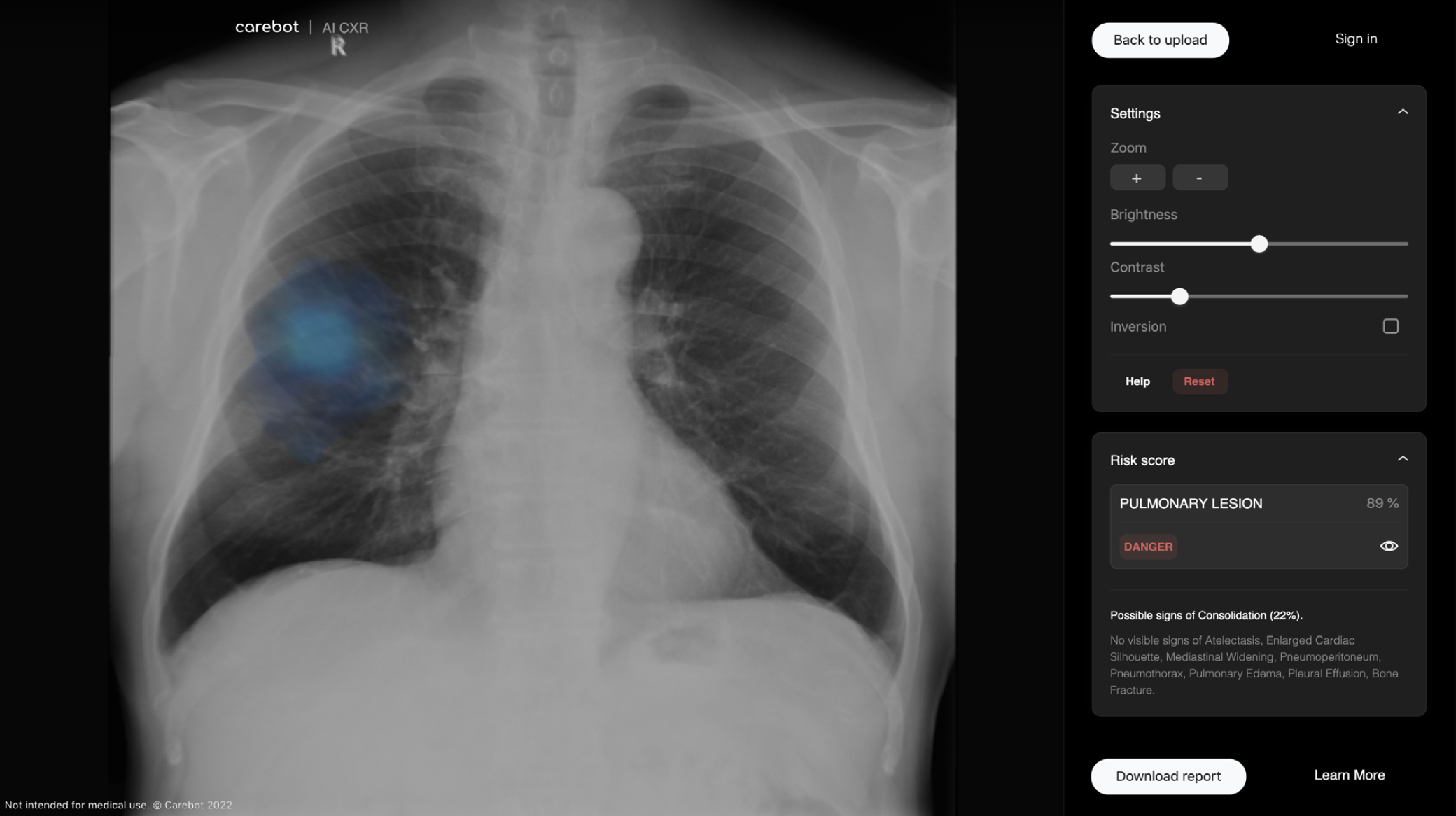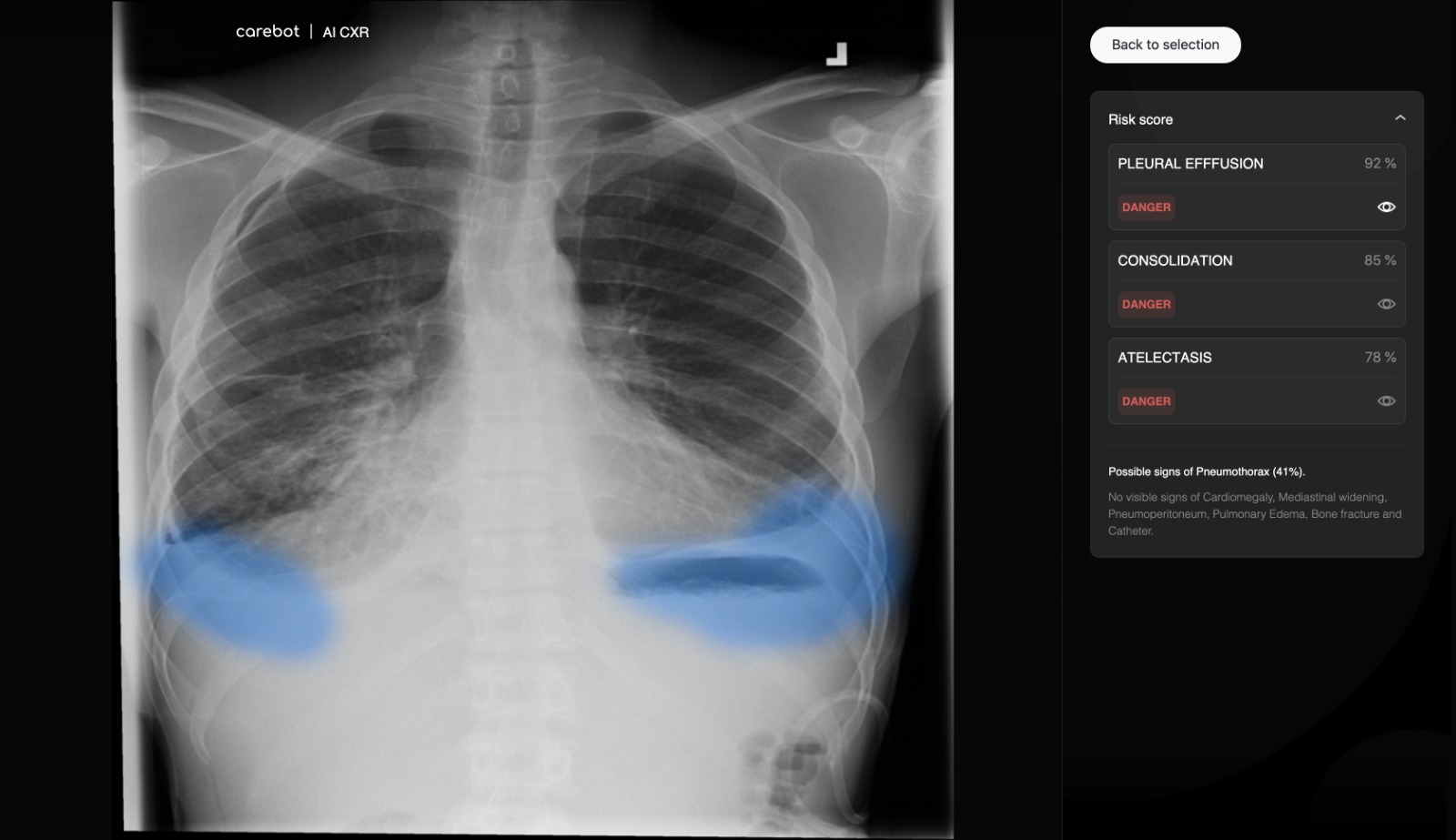Meet Carebot: The doctor’s second pair of eyes
Today it is our pleasure to present a new startup from the StartupYard program in partnership with Pilulka. Carebot is an AI that reads X-rays and helps save lives. We sat down with Daniel Kvak and Matěj Misař the co-founders of Carebot to talk more about what they do and their plans for the future.
Hi Daniel and Matěj, how did you meet and what led you to start working on Carebot?
Daniel: In university, I have been working on machine learning and artificial intelligence for the last few years. My wife Karolína was an anthropology student and worked in a lab at Masaryk University before our daughter was born. For a long time before the creation of Carebot, we had been thinking about how our fields could be combined. For example, we thought about creating a system for age estimation based on bone ossification. But instead, we saw the Covid-19 pandemic sweep through our country with extreme force. Over the course of an evening, we collected several datasets and created the first model that could distinguish between COVID/NONCOVID patients. We published a post on LinkedIn that evening and the response was overwhelming.

Daniel Kvak (right) and Matěj Misař. Credit photo: Hospodářské noviny
Matěj:
Incidentally, I saw the post and offered to help spread the word about the project. I would be sorry if such a perfect thing got bogged down in academic developments. After the first couple of weeks, Dan asked me if I would help him a little more. Dan and I have known each other for over 8 years and I was at his wedding, so I couldn’t say anything else then yes, of course, mate. From then on we started going around to doctors, heads of radiology, knocking on the hospitals‘ doors, asking, consulting with them about our solution and finally developing. From the first model became an app and a much more robust model, first, second, and third investment. It all took off in a big way.
Who is Carebot for and what problem are you solving?
Daniel: Carebot helps doctors see better, be more accurate in their diagnoses, and treat more timely and effectively. We have the ambition to become the best friend of the doctor and the healthcare system. According to studies, only 80% of diagnoses from X-rays are accurate. This means that in 20% of cases when a doctor determines what a patient’s chest findings are, they are inaccurate, or incomplete. According to our internal tests, that number is even higher. And we are addressing this major health care problem. Carebot will recommend to the doctor with high accuracy what is on the chest image and mark where the finding is located.
Matěj: And we’re not just addressing quality, which allows the doctor to detect the patient’s findings earlier, which can have a positive impact on the overall cure but also the efficiency of the process. In the last ten years, the number of images a radiologist has to evaluate has skyrocketed, while the number of doctors has remained +the same. This curve will continue to rise, which is why we are convinced that AI systems will become the standard in the healthcare system in the near future. Carebot is embedded directly in the system through which the doctor looks at the images and will speed up the whole process significantly. The doctor can then rely on the AI to confirm his diagnosis.
You are not the first startup to try solving this problem and there are already available proven solutions. Why should a company look at Carebot?
Matěj: It’s simple. We’ve come up with a method that achieves more accurate results and makes the whole diagnosis process significantly faster, including tedious administration, introducing standardization in image descriptions, and last but not least, we’re built right into the systems doctors already use. We created the entire system with doctors for doctors . We are working with respected names in the healthcare industry, with dozens of doctors from all over Europe, and we have in-house doctors and regulatory specialists in our internal team.
Daniel: Last but not least, we have a unique health data collection and annotation system. No one else in the world uses it. So we can develop in a relatively short time a very accurate model that we can put into practice faster than any of the competing solutions for much less money. We do not use publicly available datasets, the quality of the annotation of which is often questionable. While we took a year to build something like this, others took 5 years or more. Moreover, we are already scaling Carebot imagine any screening solution mammography, CT, MRI. That’s wherever Carebot will one day be helping doctors.
How big is the team and why are they a good match for this project?
Matěj: The core team consists of AI experts, the internal radiologist, the former hospital holding company CEO, regulatory and media specialists with a focus on healthcare. We currently have around 12 people.
Daniel: Close collaboration with the people who are in the hospital is important when creating such a system and putting it into practice. We work with dozens of experienced doctors from the Czech Republic and Europe who help us annotate the data and consult with them on individual findings. All this is then overseen by an experienced advisory board consisting of the head of the radiology department and former head of the internal medicine department of the largest Czech hospital, the technical director of a technology giant and a representative of bigpharma. The team we have built ensures that we achieve accurate and clear results. We have surrounded ourselves with experts who minimize dead ends in development and when they do occur, we can move in the right direction very quickly. A good team is the foundation of success.

Carebot will show the doctor with high precision what finding is located on the image
What did you see as fundamentally wrong with the healthcare industry?
Matěj: We don’t want to criticize the healthcare sector, on the contrary, we want to show that if we have technologies that can advance patient care, they should be put into practice. If we have technologies that can help us treat more accurately and more cheaply, we literally have an obligation to put them into practice. And if we have technologies that take some of the pressure off already overburdened doctors, you know how I would go on.
Daniel: We have a lot of great projects here that are technologically on the cutting edge but end up in academic development the moment the grant runs out. Likewise, we’re used to relying on ourselves and our strengths and decades of tried and tested but old practices. If we allow ourselves to leave some of our work to artificial intelligence, we will achieve better results for less time and money. It will allow the doctor to focus more on cases that are harder to assess. If we can connect people from the field, directly from hospitals, with people who understand AI, we can move healthcare decades ahead and catch up with countries that have already figured it out. Carebot can refine diagnosis, help doctors treat more accurately and more quickly, and balance the quality of care matching large hospitals with human and technological resources with hospitals on the periphery. The patient can be sure that he will receive the same quality diagnosis in Aš, Olomouc and Bruntál. AI in healthcare has huge potential, it just needs to be used.
Can you tell us a bit more about how your technology really works? How unique is your solution?
Daniel: Carebot uses artificial intelligence methods, more precisely machine learning and computer vision. It’s somewhat similar to self-driving cars, where images of traffic lights, pedestrian crossings or other cars are presented to an artificial neural network. Instead, we showed the neural network inside Carebot the images and told it: here’s a pneumothorax, here’s consolidation. Subsequently, whenever the AI is shown a new image, it can predict findings based on the features it has learned.
However, the actual deployment into clinical practice is challenging: we need to have extensive and well-annotated datasets, and accessing them is not easy. It is necessary to understand the entire scope of where AI is to be deployed, not to mention the specifics and standards that must be followed. At Carebot, we take all this into account.
Matěj:
But that’s where we are unique. The way we process and annotate data is clinically validated, and accurate. In addition, we have developed a process of continuous improvement of our models, which is a huge competitive advantage that gives us the opportunity for extremely rapid development and growth without compromising quality.
So if you are a hospital, what do you need to get started with Carebot?
Daniel: This is it. You need nothing more than the desire to treat faster, more accurately and smarter. All you need is a PACS system, which any hospital already has. Once we receive certification, there’s nothing easier than to make an appointment with us, and after a test week, we can deliver Carebot directly to your system, the viewer through which the doctor views the images. That’s all. In addition, we have tailored the financing so that it is not challenging and the benefit/price ratio is unbeatable in this case. The hospital gets a tool that compares the quality of the examination and speeds up the process for less than a euro per image. We will have tests in hospitals in the summer. If any hospital director or doctor reading this article would like to see the system, we will be happy to come and demonstrate its benefits.
What have been your team’s biggest personal or professional challenges in making this project a reality?
Matěj:
An easier question, please.
Neither of us has a medical background. So it was essential for us to get into radiology, hospital and medical practice. It’s not just to understand how the medical process works, but to find out how the healthcare financing is in the Czech Republic and other countries. It varies from country to country. Who are the decision-makers…Plus, neither of us has ever built a startup, so we learned how to build a business plan that is based on solid data. Last but not least, we then assembled a team of healthcare professionals who helped us move the whole process forward.
Daniel:
It’s actually amazing what we’ve accomplished in a year. It makes us appreciate everyone who has been and is with us in this process all the more. When we got burnt, we immediately found a way to fix it. And in doing so, we’ve maintained an incredible speed. And I haven’t mentioned how many solutions we’ve tried over the course of the year. We’ve been looking for the right model, approach to training and data acquisition. It’s all know-how we’ve learned through trial and error.
What do you hope Carebot is going to be in 5 years, as a business, or as a technology? What would be your ideal scenario?
Matěj: Carebot will be a robust but very easy to implement a system that will be used in hospitals and surgeries in several countries around the world. It will help doctors make more accurate and faster diagnoses from X-rays and CT scans, including MRIs, with a single mouse click. Carebot will help save lives by detecting findings earlier and save the healthcare system significant resources that can be used elsewhere. We anticipate rapid expansion and quality development.
Last but not least, we want to focus on the detection of rare or hard-to-detect diseases. Early detection is what can make the difference between life and death. And that is the main goal of Carebot, to deliver enough data to make the best possible decisions. To help save lives.

The application is used by the team of Carebot as a demonstration tool
Talk a bit about your experience with StartupYard. What were the surprises, challenges, highs and lows?
Daniel: The last few months have been incredibly challenging when we have been going through perhaps the most intense mentoring. Challenging, but damn enlightening. Imagine building a healthcare startup, managing the development, learning how healthcare works, raising money to grow, and having 3-4 calls a day with senior executives and experts advising and consulting with you on what to do along the way. Some days I was screaming that my life had become a calendar entry and I had time for lunch on Sundays when my girlfriend made me do it. Seriously though, we met some extremely inspiring people who helped us how to do business, build a financial plan, discussed revenue opportunities, and advised us on healthcare. We wouldn’t be where we are now without them.
Matěj: Especially Cedric and Nikola have walked the journey with us from the beginning, and even though we are still at the beginning of our project because we believe that the rocket launch is yet to come, we owe them a lot. Thanks for the hours of explanation. The last few weeks have shown how valuable those hours have been. It is also important that we realize that it is one thing to perceive the knowledge of another, but another to put it into practice. And we are succeeding in doing that.
What’s in store for you in the coming months?
Matěj: We’re deploying Carebot in hospitals, we have our first live tests in hospitals, our teams are working on developing more solutions, we’re hiring new people and we’ve also kicked off a new investment round.
Daniel: We are at the stage where we know that the first model will be able to help hospitals across Europe by 2023. We want to pick up further speed, and accelerate development and expansion so that Carebot can be deployed wherever it can help. And that is also something we hope to see from future investors. Money is one thing, but experience in the industry or expansion is absolutely crucial for us at this stage.
We have difficult months ahead of us, but we mask our crying with smiles and laughter. It’s also why when we look at what we’ve been through and what lies ahead. We are ready, we have lots of energy, many highly experienced people from healthcare around us and most importantly, we are looking forward to it!



